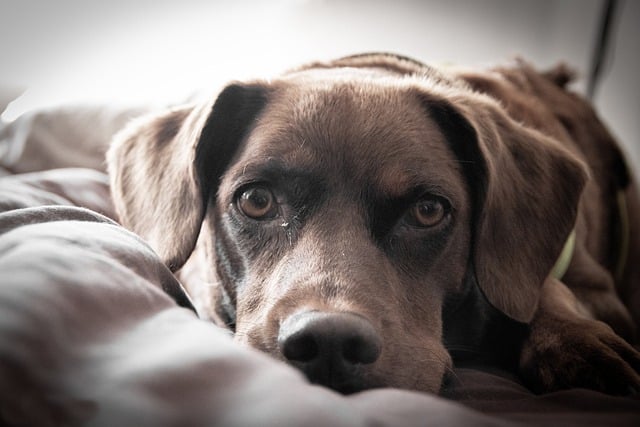When considering whether to lock your puppy in its dog crate at night, always provide a secure and comfortable crate without locking them in. This allows your puppy to enter and exit freely, reducing anxiety.
Gradual potty training, positive associations, and a consistent nighttime routine can help create a calm and relaxed environment. Age, breed, and temperament should be considered, and professional guidance should be sought. The goal is to promote a positive and comfortable space for your puppy without locking them in at night.
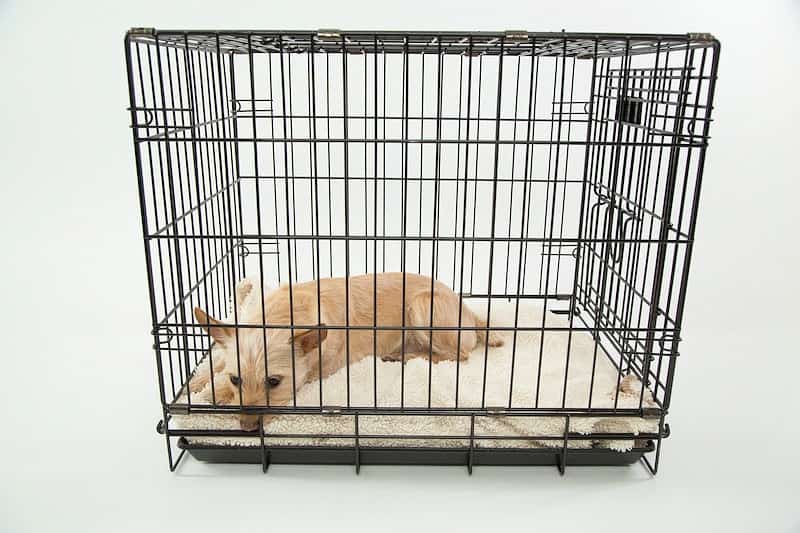
Should Puppies Sleep In A Dog Crate Starting The First Night At Home?
Introducing a crate overnight to your puppy from the first night home can benefit you and your furry friend. By providing a safe, secure space for your pup to sleep, you effectively lay the groundwork for establishing structure, routine, and good habits early on in their life.
- Building familiarity with the locked crate as early as possible is crucial to ensure its acceptance as a comforting “den.”
- Start by placing soft bedding and favorite pet toys inside while opening the door during initial introductions.
- Gradually introduce short periods of confinement with treats or praise to create positive associations with their new sleeping quarters.
As puppies begin accepting their crates as part of their bedtime routine, it becomes easier for them and you
6 Reasons To Lock Your Puppy In A Crate At Night
Locking your puppy in a crate at night can be an invaluable potty-training tool to prevent them from creating a mess. This prevents them from getting into trouble, improves your sleep, helps with anxiety, prepares for overnight vet visits, and trains your dog to stay put in case of emergencies.
1. Crating A Puppy At Night Invaluable Potty-training Tool
Crate training is an invaluable tool for potty-training your puppy, as it taps into their instincts not to soil their den. By confining your pup to a locked crate at night, you can set them up for success in learning appropriate elimination habits.
Much like human babies, puppies have small bladders and need frequent bathroom breaks during the first few months of their life. A crate-trained dog is welcome in every household.
Using a crate overnight helps establish consistency and routine, which puppies thrive on when learning housebreaking rules.By taking advantage of their instinctual behavior and positive reinforcement techniques, you’ll ensure they will quickly catch on to where it’s acceptable to go potty.
2. Keeps Puppies From Creating A Mess At Night Or Getting Into Trouble
Dog training is an effective way to keep puppies safe and prevent potential damage around the house. Being naturally curious and energetic, Puppies may get into mischief while exploring their surroundings during nighttime.
Having a designated space like a dog crate for your furry friend reduces the risks associated with these situations. It provides a haven where they can comfortably rest without access to hazardous objects or areas of the home.
Besides keeping your puppy’s environment secure, crate training helps maintain cleanliness by preventing unwanted potty accidents. It minimizes destructive behaviors such as chewing on furniture or household items.
3. Improves Your Sleep
I’ve found that crate-training your puppy significantly improves sleep quality for you and your furry friend. Like human babies, puppies need a consistent bedtime routine to encourage restful slumber.
In a secure and comfortable space in their wire crate, puppies are likelier to settle down and sleep through the night without barking or pacing.
A good example of how a crate-trained dog sleeps better is by limiting distractions to other dogs, toys, or household noises. These might keep them awake while providing a haven to protect them from potential threats.
Now as I look back crate training was a blessing. I appreciate not worrying about waking up in the middle of the night due to unforeseen accidents outside the open crate.
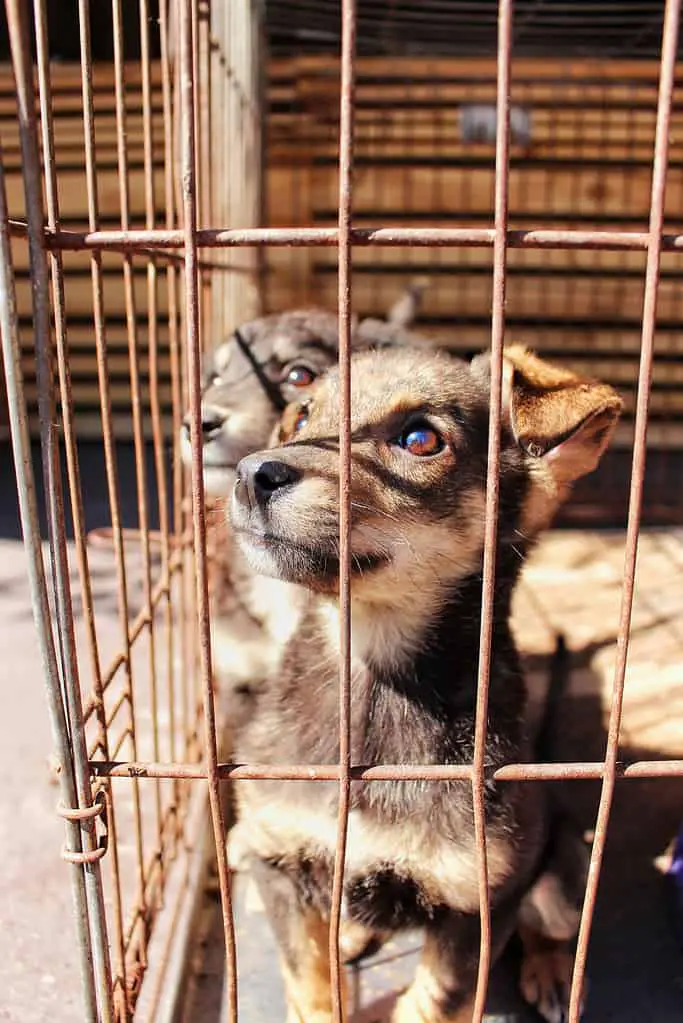
4. Helps Your Dog’s Anxiety
Crate training can also help dogs with anxiety-related issues. Providing a safe and secure space for your young puppy alleviates their anxiousness when left alone in the dark.
The enclosed environment of a locked crate promotes feelings of security in a barking puppy, which reduces stress levels. Crate training helps a young puppy to cope with separation anxiety.
I had a significant rough time trying to make my puppy sleep through the night. The incessant crying made me worried to bits. However, my rescue puppy adjusted well after the first few nights. It was indeed a relief.
Dog owners must introduce the crate positively. Gradually increase the time spent inside it so your furry friend can have a good night’s sleep.
5. Helps Puppies Prepare For Overnight Vet Visits
Proper dog training using a crate readies the young dog for overnight vet visits. Getting accustomed to spending time alone in a confined space reduces their anxiety during these visits.
Knowing how to properly crate train is very important for your pup. As the puppy spends much time in it, provide comforting items such as chew toys or blankets. Initially, keep the crate door open and slowly progress to locking them.
This has worked like magic for me- leaving the crate door open. This built up trust in my pup that I was ready to comfort them.
6. Crate-Trained Dog Reacts Better In Case Of Emergency Situations
Leaving most puppies inside a crate overnight can help them be aware in an emergency. In a fire, flood, or other life-threatening situation, the dog stays still and does not run off or get underfoot.
Focus on teaching them valuable skills from a young age with crate training. Though crate training can be helpful, remember your pup’s not guaranteed to behave appropriately in every situation. Training takes time and practice, so don’t expect miracles overnight.
7. The Crate Helps Establish Routine And Structure In Your Puppy’s Life
Crate training provides puppies with a sense of structure and routine. Dogs thrive on predictability, so having set times for meals, playtime, and sleep can give them a sense of security.
Incorporating short periods in the crate helps establish boundaries and teaches your puppy that there are times for quiet relaxation. A crate-trained dog will learn that crate time is not punishment but a natural part of daily routine. It has been mightily useful in curbing puppy barking.
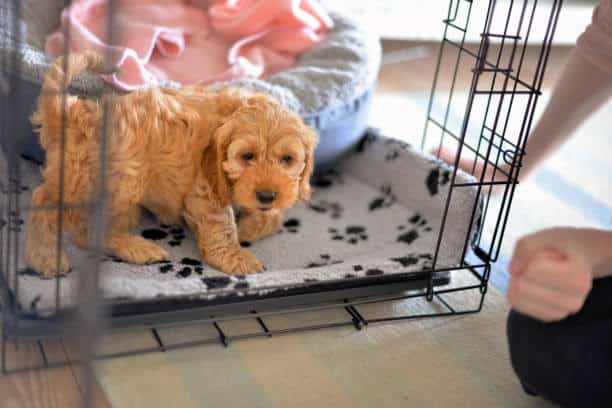
How To Crate Train The Right Way?
Crate training a puppy is essential to their development, requiring patience and consistency. Here are some tips on how to crate-train your puppy the right way:
- Choose the right size crate where you’ll make your puppy sleep. Go for a wire crate or an open crate.
- Introduce the crate overnight to your puppy during the day when they are relaxed, calm, and not tired.
- Make the crate a positive place by placing treats and toys inside.
- Begin by leaving the crate door open while your puppy gets used to it.
- Gradually increase the time you close the crate door while your puppy is in the crate.
- Provide comforting items such as blankets or soft toys to help your pup feel secure.
- Create a den-like atmosphere around the crate by placing it in a quiet area away from distractions.
- Be patient with your pup, and do not expect immediate results. Crate training can take several weeks or even months.
Following these tips, you can successfully establish a puppy’s sleep schedule. Remember to provide plenty of positive reinforcement along the way with treats and praise. And yes, puppy barking will be constant for some initial nights.
Expert Tips For Crate Training At Night With A Crate
To ensure your puppy’s nighttime crate training goes smoothly, follow these expert tips, such as introducing the crate during the day, taking them out for a bathroom break before crating, and providing comforting items.
1. Crate Size Is Important
The size of the crate is crucial when crate training your puppy. A crate that is too small can be uncomfortable for your puppy, while a crate that is too big may result in potty accidents. The ideal size of the dog crate should allow your puppy to stand up, turn around, and lie down comfortably.
A good rule of thumb is to measure your dog from nose to tail and add two inches for them to move freely. If you need help with the right size, speak with a veterinarian or check online resources for guidance.

2. Introduce The Crate To Your Puppy During The Day
Introducing the crate to your puppy daily is good for canine behavior. During the day, it is much better to address their barking as well.
- Start by leaving the crate door open and allowing your puppy to explore it independently.
- Encourage them with treats, toys, or bedding placed inside the crate.
- Ensure they do not feel trapped or confined. Keep the crate door open at the beginning.
- Praise and reward them for calm behavior while inside the crate.
- A cramped size can make puppies feel uneasy, while too much space can lead them to use one corner as a bathroom area.
To prevent destructive chewing behavior, keep chew toys within reach of your pup’s confinement area (the same goes for adult dogs).
3. Tire Your Pup Out
Before your dog sleeps in their crate at night, always tire them out beforehand. This helps them sleep better and prevents excessive puppy barking or whining.
Playing fetch, walking, jogging around the block, and engaging in games like tug-of-war or hide-and-seek has worked for me. Puppies have much more energy than adult dogs, so don’t overdo your exercise routine late into the evening.
4. Take Your Puppy Out For A Bathroom Break Before Crating
Before a good night’s rest, take them out for a bathroom break. This ensures they won’t have any accidents while inside their sleeping space and helps with potty training. Yes, they are like human babies.
Puppies under four months old also need to go outside at night, so be sure to factor in those extra trips as part of your routine. Also, avoid giving water two hours before a restful night’s sleep, which reduces the likelihood of needing a potty break during the night.
5. Take Your Pup Out Every Couple Of Hours To Go To The Bathroom.
Puppies have small bladders and may need to go outside one to two times during the night, especially if they are under four or five months old. The sooner you get them into a potty training course, the better.
Set the alarm so you wake up before your pup needs to potty. Ensure there are opportunities for middle-of-the-night potty breaks near the dog’s den.
6. Provide Your Puppy With Comforting Items
Remember that being in a crate can be stressful for your canine companion, especially when separated from their human family at night. Luckily, there are many comforting items you can provide to help ease your pup’s anxiety.
- Toys such as chew toys or stuffed animals can provide a sense of familiarity and comfort.
- Warm hot water bottles or pieces of fabric with the mother’s scent can also soothe your furry friend.
Products like the Snuggle Puppy use a simulated heartbeat to calm puppies and make them feel less alone.
7. Create A Den
A den-like crate provides them a safe, relaxing space, just like in the wild. The crate should be cozy for a good night’s sleep.
- Choose a wire or plastic crate that is the right size for your brand-new puppy to create a den-like environment.
- Add soft bedding inside the crate, such as fleece blankets or towels.
- Ensure the temperature is regulated so it’s neither hot nor cold inside the crate.
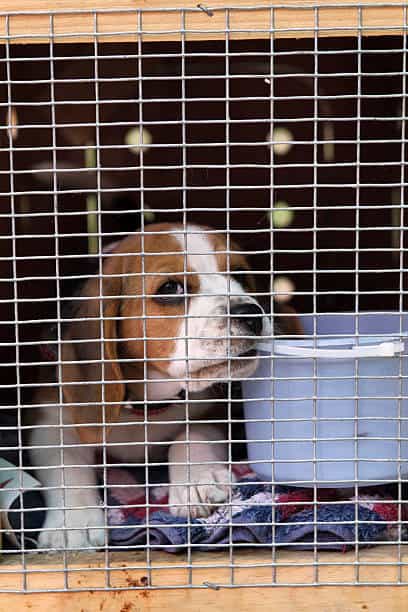
8. Be Patient
Crate training takes time. Most puppies take time to get used to their new sleeping accommodations.
- The first few nights will be the hardest. The dog whines, cries, barks, and howls. Don’t fret for it is natural as they are scared.
- Each puppy is different, and what works for one may not work for another. Be flexible on what works best for you and your canine companion.
- It can take a few weeks to months before a puppy becomes fully comfortable spending the night in its crate.
9. Don’t Expect Miracles
Now, remember, puppies are like babies, and there is no quick-fix solution. Your pup will take time to get used to sleeping in their crate.
Help your puppy adjust by gradually increasing their time in their crate during the day before beginning nighttime training. This will allow them to associate being in their crate with positive experiences like treats and praise.
What Happens If I Don’t Crate My Dog At Night?
Not crating your dog at night may lead to potty accidents, potential harm to your pet, and a not-so-silent night.
Potty Accidents
Accidents in a dog’s crate can frustrate owners and hinder their house training progress. Potty accidents can also negatively impact the pup’s sleeping routine.
- Always ensure your puppy has gone potty before bedtime and take them out for middle-of-the-night bathroom breaks if necessary.
- Leaving behind ample opportunities for outside potty breaks during the day will help minimize overnight accidents.
Your Dog Could Get Hurt
Leaving your puppy out of the crate at night may seem like a good idea to some dog owners, but it comes with potential risks. Your dogs could get hurt by chewing on electrical cords or ingesting toxic substances.
Without supervision, puppies can also swallow objects that lead to choking hazards or blockages in their digestive systems. Young dogs can wander off and injure themselves or engage in harmful behavior, such as playing with sharp objects or jumping from heights.
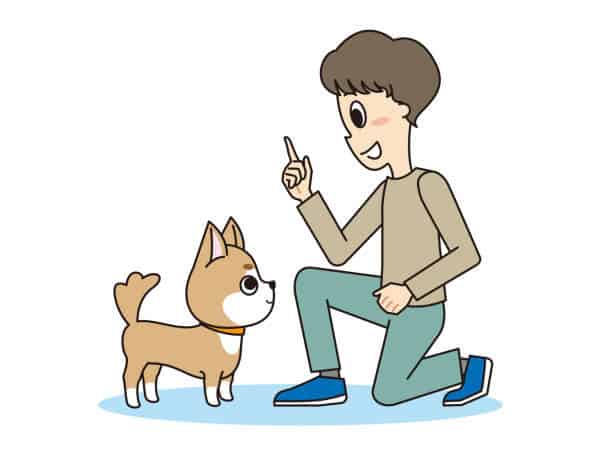
A Not So Silent Night!
Leaving your new puppy out of the crate at night can result in a not-so-silent night. Puppies are very active and curious. If they are left unsupervised, there is a high chance they will get into mischief or make noise that disturbs everyone’s sleep.
Crate training your puppy will provide them with a safe space to rest peacefully without any worries. However, in some cases, the crate may cause discomfort. If your dog whines and barks, get them an open crate.
Proper crate training is the foundation for proper potty training in many dogs. Also, it reduces risks associated with damaged furniture and chewed-up household items caused by teething.
What Should You Do If Your Puppy Whines Or Barks In Their Crate?
If your puppy whines or barks in their crate, it could be a sign of distress, a need for a potty break, or demand barking; check on them and address the situation accordingly to continue successful crate training.
Distress Barking
Distress barking is a high-pitched, sharp bark or cry that signals your puppy’s discomfort and anxiety. It can be caused by various factors, including fear of being alone, separation anxiety, and illness.
If your pup starts to distress bark at night in its crate, it may need reassurance through calming scents or toys. Ignoring the barks could lead to long-term anxiety and other behavioral problems for you and your furry friend.
However, taking them out of their crate might teach them that crying means no crate time, further complicating matters.
Demand Barking
Demand barking is a common behavior exhibited by puppies when they want something from their owner. This can include attending a potty break, getting attention, or being let out of the crate.
- Many dog owners respond to their puppy’s vocalizations for a bathroom break to prevent accidents in their crate.
- Waiting for a few seconds of quiet before opening the crate door can help prevent demand barking.
This is also an opportunity to practice teaching your puppy the “Quiet” command.
Need For A Potty Break
Potty breaks are essential for puppies. Ensure you let puppies pee and poop before entering their crate at night. Puppies have small bladders and can only hold them in for a few hours.
Providing multiple potty breaks before bedtime If a puppy does wake up needing a potty break, make sure there is a safe spot nearby. However, they tend to do fewer mishaps as they become more potty trained.
Take the pup outside immediately and wait patiently until they finish their business. Avoid playtime, petting, or any other distraction that may lead them back inside and out later.
Potty accidents in the wire crate can cause setbacks in house training. Hence, owners must track how often their puppies go outside each day after meals/snacks/drinks/etc.
Be encouraging by saying “go pee-pee” or using another phrase consistently. Hence, they start associating words with actions that reinforce good habits, like delivering treats immediately upon finishing their business outdoors!
Setting Up Your Puppy’s Crate Area For Nighttime Rest
To ensure your puppy’s nighttime rest is comfortable and stress-free, set up their crate area with a calming pheromone diffuser, a cozy bed or blanket, and consider using a white noise machine to help mask any distracting sounds.
Calming Pheromone Diffuser
A calming pheromone diffuser can be a game-changer for many dog owners who want to make crate training easier. These diffusers mimic the naturally soothing scents that mother dogs release to calm their puppies, creating a relaxing and familiar atmosphere for young pups.
One popular option is Adaptil. This brand offers a range of products designed specifically for dogs, including plug-in diffusers, collars, and sprays. Many dog owners have reported positive results with Adaptil products, noting that they seem calmer and more relaxed after using them.
Calming Snuggle Puppy
A calming snuggle puppy is great for calming puppies down inside the dog’s den. This stuffed animal has a heartbeat simulator miming the sound of its littermates’ heartbeats, providing comfort and making them feel less alone. Many dogs find comfort in having something soft to cuddle up against in their crates
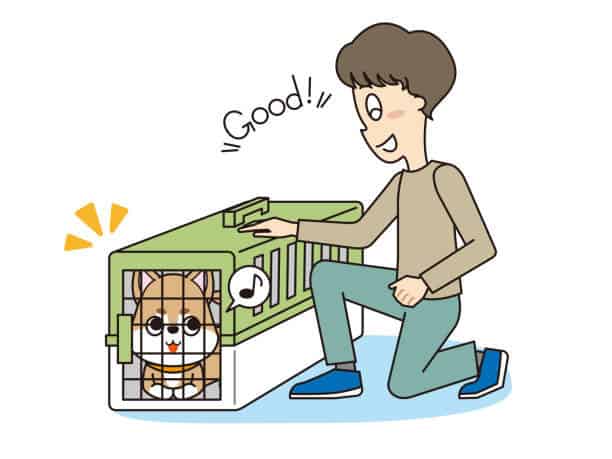
A Fan Or Sound Machine For Noise Masking
A fan or sound machine can create a peaceful environment for your dog’s crate area. The white noise produced by these devices can help soothe and make the puppy feel more secure, a relief for puppy owners.
A fan provides a cool breeze ideal for hotter months while reducing excess light that could wake your pup through its effect on air particles.
It is essential to choose the appropriate device based on your puppy’s needs and place it near its crate. However, ensure it isn’t directed towards them as this may cause discomfort.
It should also not replace proper crate training techniques and precautions. Neglecting necessary steps may negatively impact your dog’s behavior in the coming weeks or months.
Should You Cover Your Puppy’s Crate?
Covering your dog’s crate at night is a personal choice that depends on your pup’s specific needs. Some puppies do well with their entire crate covered, while others need at least the door of their crate uncovered.
Covering a dog’s crate can help remove excess light and muffle sounds that could wake them up, especially for light sleepers.
Additionally, waterproof or machine-washable mats can prevent potty accidents during the night. Consistent opportunities for middle-of-the-night potty breaks are very important for your canine companion.
The Humane Society recommends placing the crate in the owner’s bedroom or a hallway near them so they can hear the puppy cry if it needs to go to the bathroom.
Your Puppy’s Preferred Bedding: Warm And Cozy Or Minimal And Cool?
Some puppies enjoy warm and cozy blankets or beds, while others prefer minimal and cool surfaces.
- Durable materials like elevated cots can be used for chewing-prone pups.
- Clip-on water bottles or bowls can be used in crates to minimize the risk of spills.
- Sound machines can create background noise that can help the pup sleep soundly.
Fast Fix– What To Do …
When My Puppy Pees In The Crate At Night?
Your puppy could be peeing in their crate because they haven’t gone for a potty break f before bedtime. Puppies have small bladders and need consistent and proactive nighttime potty breaks to avoid accidents in their crate.
- Set the alarm for a fixed time to wake up to check on the dogs
- Make sure your bed is near the crate and the dog bed initially.
- Use vocalizations to assure the pup calmly.
- Feed your pup three to four hours before bedtime.
When My New Puppy Won’t Stop Barking In A Crate At Night?
If your new puppy will continue barking in their crate at night, it’s crucial to determine the reason. Do they need a potty break?
- Instead of letting them out of the crate, take them outside for a bathroom break and straight back into it.
- You mustn’t digress from your established routine.
- Tiring out your pup before bedtime can also help reduce distress barking.
- Comforting items in the crate, such as chew toys or a snuggle puppy, can also help calm them down.
When My Puppy Hates Crate At Night?
- If your puppy hates being in their crate at night, try making the space more inviting.
- Provide a cozy dog bed and add items like a Snuggle Puppy to make it feel like a haven
- Increase the time they spend inside this open crate during day time.
Additionally, it’s essential to consider if there is an underlying issue causing anxiety or discomfort for your puppy while in its crate.
They may be experiencing separation anxiety, which can be addressed with desensitization training techniques or seeking advice from a professional dog trainer.
When My Puppy Won’t Sleep In The Crate At Night?
It can be frustrating when your puppy won’t sleep in its crate at night, but trust me, it is a process.
- Ensure the crate is properly sized and comfortable.
- Feeding meals on time can work wonders for puppies
- Always give them treats or praise.
- Make them exercise or run so they get tied and hit the dog bed easily
- Try placing an old article of clothing with your scent inside to comfort them, or use a calming pheromone diffuser.
When My Puppy Won’t Stay In The Crate At Night?
If your puppy won’t stay in the crate at night, handling the situation with patience and understanding is essential.
- First, avoid forcing your pup into the crate or using punishment, as this can create negative associations with the crate.
- Another technique is establishing a bedtime routine and keeping the crate door open at the beginning.
- Make sure the dog bed is comfy. Go for an open crate or a wire. Most dogs and puppies at the beginning react better to them.
- Don’t leave too much space free in the crate. Add soft toys or a blanket.
- Ensure they have had all necessary potty breaks before settling for the night.
When My Puppy Is Panting In A Crate At Night?
If your puppy is panting in its crate at night, it could be due to a few reasons.
- Firstly, the crate might be too warm or poorly ventilated, causing the puppy to overheat and pant excessively.
- Secondly, your pup might feel anxious or even scared of being alone in the crate during nighttime.
- To alleviate this issue, make sure you create a comfortable sleeping environment. Place their crate in a well-ventilated area and keep it cool.
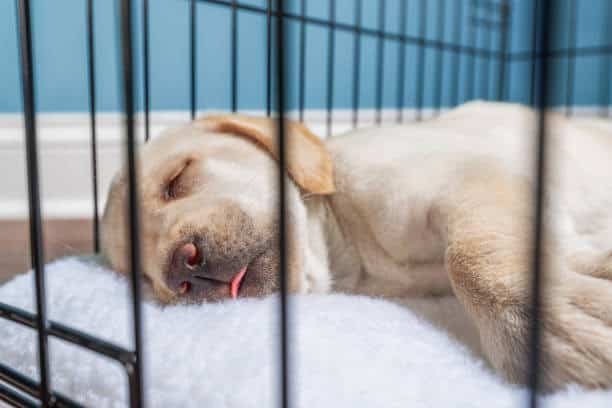
Examples Of Nighttime Puppy Crate Setups
When setting up your dog’s crate for nighttime use, it’s essential to consider various factors that will make the space comfortable, cozy, and secure. Here are some examples of nighttime puppy crate setups to help you create the perfect environment for your furry friend.
| Setup | Features |
| Basic Crate Setup | Includes a properly-sized crate, comfortable bedding, and a blanket or cover for security. No extra toys or distractions. |
| Potty Training Setup | Features a crate with a divider to create a sleeping area and a separate potty area with puppy pads or a litter box. This setup suits young puppies still learning to hold their bladder through the night. |
| Anxiety Relief Setup | Incorporates a calming pheromone diffuser or calming snuggle puppy near the crate, soft and cosy bedding, and soothing background noise from a fan or sound machine. |
| Chewing Deterrent Setup | Includes durable chew-resistant bedding and appropriate chew toys inside the crate to discourage destructive chewing while still providing a comfortable sleeping area. |
| Enrichment Setup | Offers one or two puzzle toys or interactive toys that can be filled with treats, allowing the puppy to focus on a calming activity before falling asleep. |
| Temperature Control Setup | Features a cooling mat or a heated pad depending on the climate and your puppy’s preferred sleeping environment, ensuring they stay comfortable throughout the night. |
| Travel Setup | Equipped with a portable or collapsible crate that can be easily set up in a new environment, helping your puppy feel secure and comfortable when away from home. |
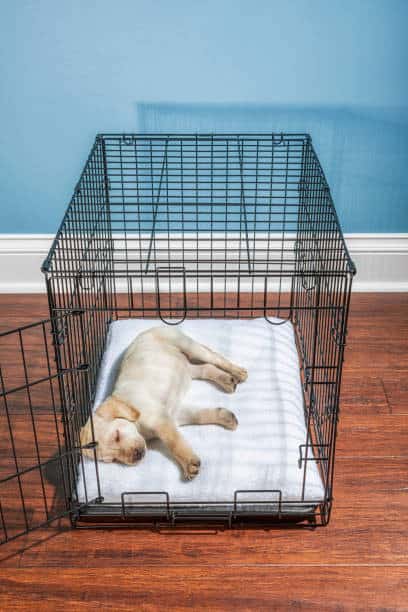
FAQs about Crating
Should I cover my dog’s crate at night with a heavy blanket so it won’t move?
You can cover your dog’s crate at night with a heavy blanket to help them feel more secure and block out disturbing light or noise. However, ensure that the blanket is not too heavy or will not restrict your puppy’s breathing.
How long should you crate a puppy at night?
The time you can crate a puppy at night will vary depending on its age and temperament. A general rule of thumb is to crate a puppy for no more than 2 hours for every month of age. So, for example, an 8-week-old puppy should not be crated for more than 16 hours per night.
How to get the puppy into the crate?
You can do a few things to get your puppy to enter their crate. First, ensure that the crate is comfortable for your puppy and located in a quiet and safe place.
You can also try feeding your puppy in their crate or giving them treats when they go inside. If your puppy refuses to enter the crate, you must be patient and consistent with your training.
When to put the puppy in the crate at night?
You should put your puppy in their crate at night when they are tired and ready to sleep. This will help them associate the crate with a positive experience and make it more likely that they will go inside on their own.
Should you cover your puppy’s crate at night?
Covering your puppy’s crate at night can help them feel more secure and block out any light or noise disturbing them. However, ensure that the blanket is not too heavy or will not restrict your puppy’s breathing.
Where should you put your puppy’s crate at night?
The best place to put your puppy’s crate at night is in a quiet and safe place in your bedroom. This will help your puppy feel more secure and make it easier for you to hear them if they need to go to the bathroom.
Should You Have Water in Your Puppy’s Crate?
You should provide your puppy with water in their crate at night. However, ensure the water bowl is manageable and will not spill over.
Should I close the crate door at night?
Yes, you should close the crate door at night. This will help your puppy feel more secure and prevent them from getting out of the crate and getting into trouble.
Should I put my 8-week-old puppy in a crate at night?
Yes, you should put your 8-week-old puppy in a crate at night. This will help them learn how to sleep through the night and prevent them from getting into trouble.
When should a puppy stop sleeping in a crate at night?
Most puppies can stop sleeping in a crate at night when they are about 6 months old. However, some puppies may need to sleep in a crate longer, depending on their needs.
Where should I put my puppy at night?
Once your puppy no longer sleeps in a crate at night, you can put them in their bed or on the floor in your bedroom.
Is it OK to let a puppy cry in a crate at night?
Letting your puppy cry in their crate at night is not recommended. If your puppy is crying, it is likely because they are scared or uncomfortable.
Try to soothe them by talking to them in a calm voice or by petting them. If your puppy continues to cry, you may need to take them out of the crate and let them sleep in your bed.
How long does it take for a puppy to stop crying in the crate at night?
The time it takes for a puppy to stop crying in the crate at night will vary depending on the individual puppy. Some puppies may stop crying within a few days, while others may take several weeks. Never punish your puppy for crying in its crate.
Author Profile
- Site Owner And Planning Specialist
-
Aritra, the founder of Labradorandyou.com, is a lifelong dog lover whose passion ignited for Labradors for their loyalty and intelligence. With extensive research and personal experiences, Aritra has become a Labrador expert, offering a rich resource on the breed. Labradorandyou.com provides reliable, timely, and evidence-based information, including Labrador-specific product reviews, training techniques, and care tips.
Labradorandyou.com was born out of Aritra's passion and his desire to share his profound knowledge about the breed. The site serves as a comprehensive resource, offering a wealth of up-to-date information for Labrador owners and enthusiasts alike
Also by the author
-
 FAQNovember 17, 2023How To Adopt An Emotional Support Dog?
FAQNovember 17, 2023How To Adopt An Emotional Support Dog?
-
 Mix-BreedsNovember 16, 2023Red Labradoodle Ultimate Guide: Breed Facts, Care Tips
Mix-BreedsNovember 16, 2023Red Labradoodle Ultimate Guide: Breed Facts, Care Tips
-
 Top BreedersNovember 8, 2023Breeding Labradors: Everything You Need to Know
Top BreedersNovember 8, 2023Breeding Labradors: Everything You Need to Know
-
 FAQOctober 17, 2023Do Dogs Like Music? Researchers Say Yes! Find Out
FAQOctober 17, 2023Do Dogs Like Music? Researchers Say Yes! Find Out

